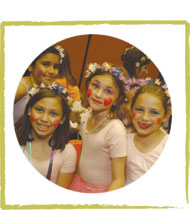Educating Children in the New Millennium: Child’s Play
By Steve Webb
|

What we can learn from children
I’d like to share a story. This is a story about my daughter Tess, who will turn four this August. She’s been in our home since August of 2004, when we adopted her from China. She has been a blessing in so many ways, and she teaches me something new every day, if only I pause long enough to listen and observe. Certainly, as a first time parent, she has taught me a great deal about patience; she moves at a different speed and to a different drummer. She also has reinforced what I know is best in terms of how children learn. This is a story that begins at our kitchen table, traverses through our community, and concludes in the global marketplace.
|
Wiggles and Piaget
Tess is in love and has been for some time. Her passion is the Wiggles, a children’s performance group out of Australia. At two she was in love with Jeff Wiggle whose character wears the purple shirt. She wore that shirt for a year and now has enshrined it in a special place in her closet. Her new crush is Greg Wiggle whose character wears the yellow shirt. Fickle perhaps, but she is only three. Recently, as we were saying grace before an evening meal, it was Tess’ turn to identify one thing for which she was thankful. You guessed it—“the long-sleeve yellow Wiggles shirt with the logo on the side.”
We know that our daughter is constructing mental maps based on her experiences. Jean Piaget, distinguished child psychologist, described this early childhood development stage as pre-operational. He theorized that a child’s mental models or cognitive structures are based on a child’s activities. Engagement is how a child makes meaning.
|
The Importance of Play
A recent report, “The Importance of Play in Promoting Healthy Child Development and Maintaining Strong Parent-Child Bonds,” from the American Academy of Pediatrics (AAP) stated that free and unstructured play is healthy and—in fact—essential for helping children reach important social, emotional, and cognitive developmental milestones. Piaget’s theory is based on the idea that the developing child builds cognitive structures known as mental “maps” or schemes (networked concepts) for understanding and responding to physical experiences within his or her environment.
Constructivism, a theory of learning, is founded on this premise that, by reflecting on our experiences, we construct our own understanding of the world. Each of us generates our own “rules” and “mental models,” which we use to make sense of our experiences. Learning, therefore, is the process of adjusting our mental models to accommodate new experiences. Constructivist teaching models focus on creating experiential, engaging, and "hands-on" activities for students. An example of a constructivist teaching strategy is having students participate in a science fair. This kind of learning also involves an element of play.
|
Balance
What does any of this have to do with educating millennial children? Many students today are not benefiting from a balance of intellect and imagination. The AAP reported that the following forces have impacted free play and unscheduled time negatively for children:
1. Changes in the family structure (e.g., more two-income families, single parent families, grandparents raising grandchildren, etc.)
2. Competitive college admissions process (e.g., stressed out parents competing for admission into the right preschool programs, or over-scheduling children as toddlers or adolescents)
3. Federal education policies that have led to reduced recess and physical education in many school systems (e.g., Tacoma Public Schools—some ideas are simply bad for kids, and cutting out recess is one of them).
Even worse, some school systems have reduced or eliminated curricular programs—music, visual and performing arts, and physical education—that look like play to some people. Increasingly, a significant body of neuroscience research suggests that the arts (and play) significantly impacts students’ cognitive, social, and emotional development. From a Piagetian perspective, we know this is true in theory. Recent developments in neuroimaging technologies (brain based research), however, have added another important research dimension: allowing scientists to observe how various processing systems in the brain collaborate when they develop a decision and then activate the appropriate behavior. Play, the arts, and physical education have inherent value, yet new technologies demonstrate a significant link between artistic and cognitive development.
|
Continued 1 | 2 | 3 | 4 | 5 |
|
 |